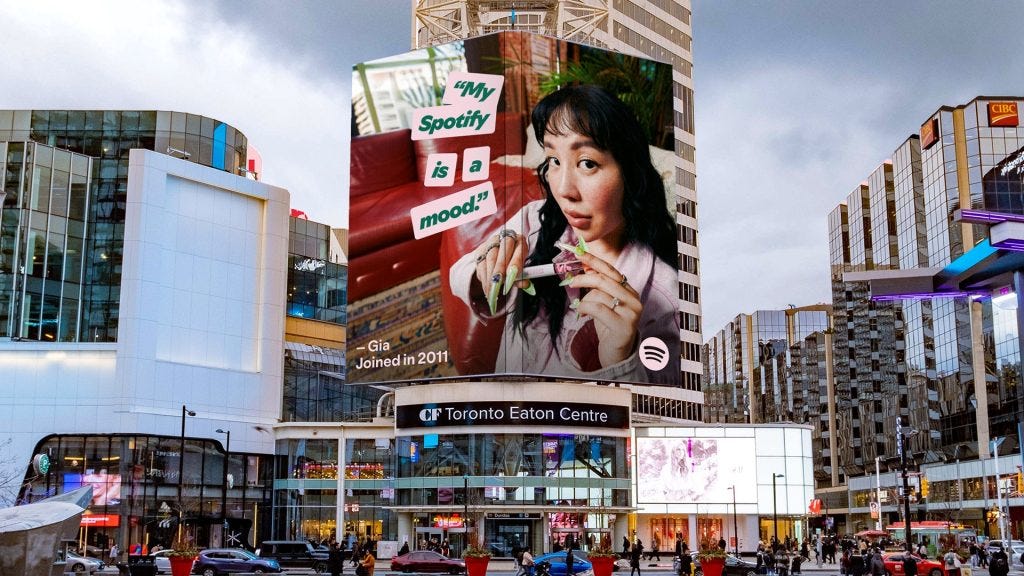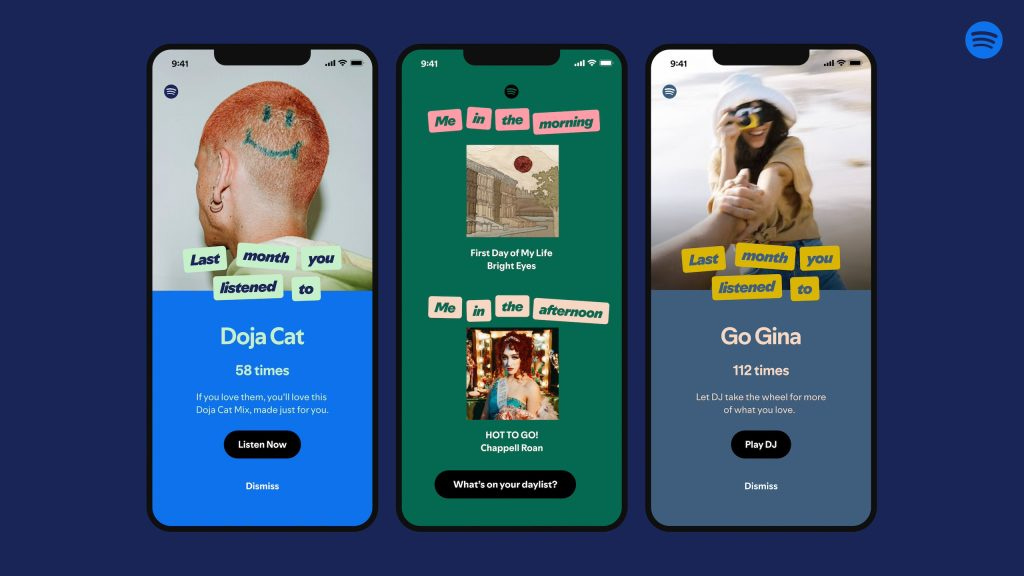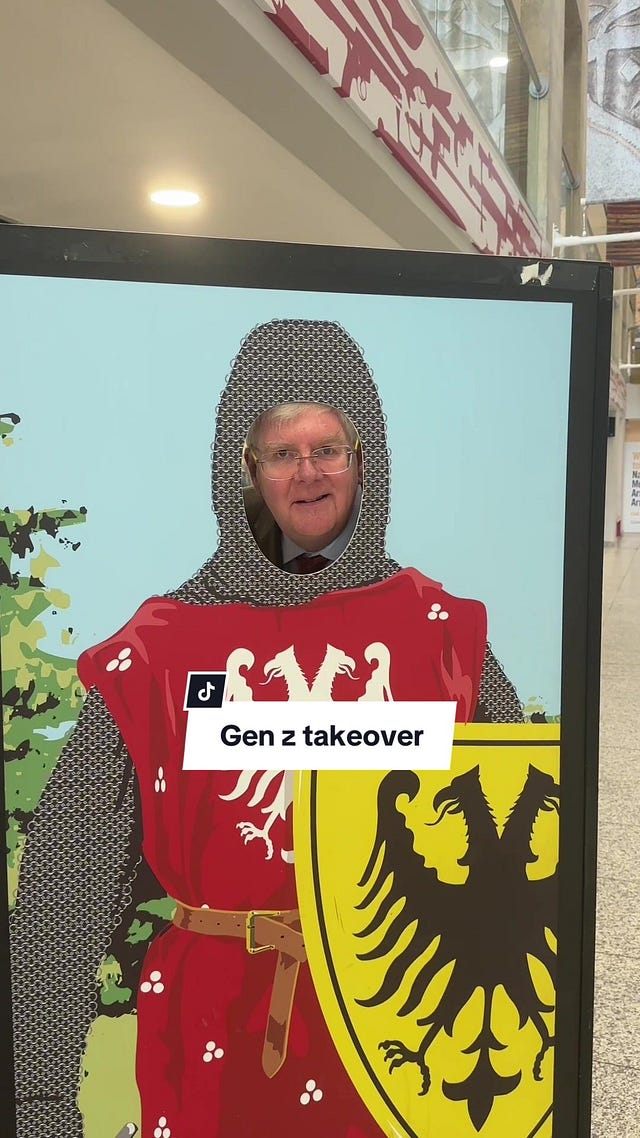How Spotify are winning with Gen Z
daylists & immaculate vibes
Welcome to the latest edition of The Gen Zer. This week, we take a deep dive into the world of Daylists, Blends and the annual Wrapped as we look at how Spotify is winning with young users. We also cover some big changes to young users’ Instagram accounts, the National Gallery’s attempts to attract Gen Z, and more.
Ask Gen Z what their favourite brand is, and there’s a good chance that at least a few will say Spotify. From personalised playlists, to niche podcasts, to the Christmas craze of Spotify Wrapped, Spotify have managed to engage Gen Z by creating a music platform that is simultaneously uniquely tailored to you whilst also creating a collective, shared experience.
Gen Z don’t make up all of Spotify’s users, of course, although the platform’s listeners do skew young: 55% of users are aged 18-34, and the most energetic users — the ones sharing their Spotify Wrapped on their stories, or creating collaborative playlists with friends — are typically from the youngest generations.
And whilst we’re discussing stats, it’s worth pointing out that Spotify are doing particularly well at the moment. It has over 626 million active users (a year-on-year growth of 14%) with around 246 million of those users paying for premium (the rest generating revenue for Spotify through ads on the platform’s freemium model). Total revenue increased by 20% compared to last year.
A lot of this growth has been part of a deliberate, targeted expansion by the platform. Spotify began offering podcasts three years ago and has added millions of episodes since. Similarly it has massively expanded its geography, adding over 80 countries since 2020 to bring the total number to 184.
But Spotify’s biggest achievement isn’t in just expanding its array of features, but in the way it has moulded its products and its marketing strategies together. Spotify Wrapped is the most obvious example of this. What Spotify have done here is to create a marketing asset that doubles as a fun, quirky feature for users — one that they will then share millions upon millions of times across social media.
Maybe that sounds like a cynical way of looking at things, but I think Spotify’s success lies in the fact that most of us don’t mind acting as unofficial brand ambassadors. I probably wouldn’t share a Deliveroo Wrapped to my Instagram story or ask a friend about their Nike statistics, but with Spotify it never feels like they’re trying to sell you something. Perhaps it’s because it’s a subscription model, so once you’re a premium subscriber you can’t really spend any more money. But I think it’s also to do with how they’ve approached these new products — putting both the user and shareability at the heart of the experience, and making it all pretty fun and silly, too.
I remember back in December reading a lot of pieces about how the challenge for Spotify is to recreate the monthlong buzz that Spotify Wrapped brings all year round.
Back in September they had released their new Daylists feature, although it took a while for many users to take notice. If you don’t know, your Daylist is a playlist that updates multiple times a day, suggesting the kinds of music that you normally listen to at that time on that day. So say you normally listen to jazz on Saturday mornings, then next Saturday your Daylist might be called something like ‘Jazzy Grooving Saturday Morning’ and give you a mixture of songs you listen to regularly, along with quite a few you’ve likely never heard before. Then, later on, it might update to ‘Soul-Crushing Blues Saturday Evening’ or anything else, based on what you normally listen to then.
Attention to Daylists has steadily grown since September. The key thing is, as with Wrapped, your Daylist will be almost completely unique to you. Your Wednesday afternoon might be a ‘Romantic Pop Wednesday Afternoon,’ whereas your friend’s might be a ‘Bed Rotting Metalcore’ one instead. It’s a fun feature, and the personalised aspect (not to mention the sometimes hilarious names) mean that every now and then my friends and I will pull out our phones and check what everyone’s Daylists are currently called. From a marketing perspective, it’s a great way to boost word-of-mouth referrals.
Personalisation can be a double-edged sword, of course. Not everyone likes brands collecting vast amounts of user data and then personalising ads or products a bit too well — it can very quickly feel overbearing, or even creepy. But by keeping the focus on music and having fun with friends, Spotify mostly avoids this.
Indeed, music streaming is uniquely suited to such hyper-personalisation because our music tastes are one thing we often want to be hyper self-interested about. If your banking app reminds you what you’ve been spending all your money on, it might not feel great. But finding out your most listened to artist or genre from last month? It’s much nicer.
The experience of listening to music is, in a funny way, both a collective, shared experience and also a completely personal one. People have been coming together to enjoy music for thousands of years, and music is often there at the biggest events in our lives, like weddings or birthdays. At the same time, when you listen to music it’s a wholly unique experience — it’s just you and the artist, and no one’s experience of listening to that music will be quite the same as yours. A song might mean something completely different to you than it does to them.
Spotify is winning with Gen Z because it has tapped into both of these aspects of music. On the social side, it’s made sharing playlists and your own user data incredibly easy and fun, from Daylists to Wrapped to ‘Blends’, which merge your music taste with a friend’s. And that’s not to mention all the community content across their socials, like Spotify Singles, interviews with artists, and even documentaries.
And on the personalisation side of things, there’s an absolute tonne of different features. Not only is the platform’s algorithm really good at suggesting new music, but it’s constantly creating playlists just for you — from Discover Weekly to Release Radar to a daily range of mixes based on the different genres and artists you listen to most.
Its most recent marketing campaign, ‘My Spotify’, emphasises this hyper-personalisation. It features a range of celebrities and users with the tagline ‘My Spotify is…’. For some, it’s super organised and curated; for others it’s simply a mood, or a portal back to the 90s, or ‘deeply uncool.’
“It’s not about creating one Spotify experience,” Matt Luhks (senior director of global marketing at Spotify) recently told Ad Age. “It’s about creating 626 million unique Spotify experiences. ‘My Spotify’ is about how marketing can help create an even deeper relationship between our users and the products.”
Luhks also talked about how the different ways young people engage with music is also informing Spotify’s overall strategies. “[Young people] move more fluidly between genres. Different genres reflect different parts of their identity. And sometimes that even changes throughout the day.” Hence the Daylists.
It’ll be interesting to see what Spotify does next, and whether its competitors — such as Apple Music, Amazon Music and Tidal — can find a way to keep up. For now, I’ll get back to my ‘Sad Girl Art Deco Thursday Afternoon’ and leave you to the rest of the newsletter.
See also:
Gen Z around the Web
the latest stories in youth culture and changing trends . . .
Instagram is restricting teen accounts—and blocking sneaky workarounds (wsj)
Following years of criticism about child safety, Instagram said it would shift 100 million teenagers in the U.S. and around the world into restricted accounts, meaning that they won’t see sensitive content such as videos of fights or posts promoting cosmetic procedures — and Instagram’s algorithm won’t recommend sexually suggestive content or content about suicide and self-harm, either. It’s slightly mad that they are only just doing this, but it’s a reassuring move nonetheless. Read more
How Gen Z are ‘rizzing up’ the UK’s stately homes (i news)
The National Gallery is apparently trying to shake off its “stuffy image” by appealing to TikTok. As the museum celebrates 200 years of existence, it’s enlisted 200 social media influencers to help make the centuries-old masterpieces “trend” on TikTok. Read more
“Working from home is no life for the young” (the times)
I’m always interested in the various conversations around Gen Z in the workplace. Many of us started our careers after or during the pandemic, and there is a wide range of opinion about whether flexible working has been good for us. This article takes a more negative view of remote work — for young people, it’s just another trend towards loneliness and isolation. Read more
More Gen. Z and Millennials say they feel most like themselves ‘online’ than ‘offline’ (new consumer)
In a survey that highlights a key difference between the younger generations and the older ones, more Gen Z and Millennials say they “feel most like themselves” online, rather than offline. For Gen X and older generations, it’s the complete opposite. This trend is particularly interesting when you consider something like how Kamala Harris’s presidential campaign has adopted a very “online” tone of voice. For marketers, digital space is where they aim to meet young consumers first and foremost. Read more
Letting Gen Z write the marketing script (tiktok)
One light-hearted trend that’s been making the rounds online is the ‘We let our Gen Z intern/colleague/child write the script.’ It’s a playful take on the bemusement that age gaps can bring, especially when it comes to the latest vocabulary of choice. (If you don’t know the difference between sigma, based, rizz or a tomato girl, I honestly wouldn’t worry too much.)
That’s all for this week! Make sure to subscribe for the latest on Gen Z and youth culture, and check out The Common Thred for a weekly roundup of the latest news, trends and thought pieces.
See ya soon,









